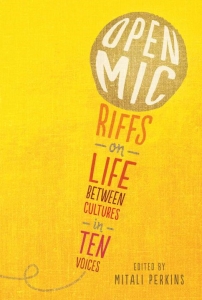2018 School Spending Survey Report
Five questions for Mitali Perkins
Author and blogger Mitali Perkins was born in Calcutta and raised in suburban California, with stops along the way in Africa, the UK, and Mexico.
 photo courtesy of the author
photo courtesy of the authorAuthor and blogger Mitali Perkins was born in Calcutta and raised in suburban California, with stops along the way in Africa, the UK, and Mexico. She has written fiction about Burmese boy soldiers (Bamboo People, Charlesbridge 2010, 11–14 years); a Bangladeshi girl disguised as a boy (Rickshaw Girl, Charlesbridge 2007, 10–12 years); Indian and half-Indian, respectively, young women (Secret Keeper, Delacorte 2009, 14–16 years; Monsoon Summer, Delacorte 2004, 14–16 years); and a Pakistani American child of POTUS (First Daughter series, Dutton, 10–12 years). Cultural identity is key, and her latest book, Open Mic: Riffs on Life Between Cultures in Ten Voices (Candlewick, 12–14 years), looks at the funny behind the frequently fraught issue.
1. What’s so funny about being Indian American? (Or do you prefer South Asian American?)
MP: I never know what to call myself ethnically; it's your pick. There's plenty to mine in the funny fields when you grow up between cultures. Consider, for example, the intersection of North American pop culture, your parents' Old World views, and the word "romance." If you don't start laughing while you're squeezed in that corner, you'll end up spending a lot more on therapy. And saving money thrills the immigrant part of you while the New World part of you disdains that you delight in coupons and bargains. Shall I go on?
2. How did you select your contributors for this collection?
MP: Some I knew could write funny. Others hadn't expressed their humor in their work but were hilarious on social media. A few had a light, witty touch to their writing that I wanted to include. One (Debbie Rigaud, "Voilà!") won a contest that I promoted in 2011 via my blog, Twitter, and Facebook.
 3. The tone of the pieces is so varied, from LOL funny to highly introspective. What guidelines did you give the writers?
3. The tone of the pieces is so varied, from LOL funny to highly introspective. What guidelines did you give the writers?MP: Here's a bit of what I sent them:
“Why go for a combination of humor and race? It’s easy to see teens exploring boundaries, definitions, and trends in ethnicity and race in standup comedy, sitcoms, and funny short and long films. Meanwhile, teen novels confronting these topics tend to be serious, reverential, or sad. Humor crosses borders like no other literary device. Shared laughter fosters community and provides the freedom to talk about issues that might otherwise cause division or discomfort.
Your Open Mic story, poem, or essay could include poignant, deep content as well as laugh-out loud hilarious scenes. Contributing writers don’t have to focus specifically on racism, but can explore or illuminate any aspect of culture and community along the margins of race and culture in North America. Our authenticity and humor, hopefully, will inspire teens to talk about their own experiences as they share the book in classrooms, families, and through social media.”
4. Who are your own inspirations, both comedic and civil rights-wise?
MP: My father is hilarious. And my mother loves a good belly laugh, too. Our family bonded over out-of-control, shared laughter. So the parents and sisters, first and foremost. Old-school professional? Lucille Ball, for sure. Today's comedians? Mindy Kaling. Tina Fey. Aziz Ansari. Russell Peters. Mahatma Gandhi (was he funny? I think he must have had a sense of humor with a smile like that.) MLK, of course. No idea if he was hilarious, but a riveting preacher usually has a good sense of humor. Mother Teresa — I hope my face is aging with all of those laugh crinkles, don't you? And Jesus. Jewish humor is legendary, and that man definitely drew a crowd.
5. To riff on the multiculturalism question, “Who can tell whose stories?”: Who do you think can tell whose jokes?
MP: That's a tough one. I'd like to announce that there should be no apartheid in telling jokes, but since humor is more powerful than other kinds of storytelling perhaps we must be more circumspect. Check out my three rules of good humor in the introduction to Open Mic, and tune in to teen culture — their answers to this question would differ from my generation's, but even their rules about race are changing so fast it's hard to keep track.
From the August 2013 issue of Notes from the Horn Book.
![]()
RECOMMENDED
ALREADY A SUBSCRIBER? LOG IN
We are currently offering this content for free. Sign up now to activate your personal profile, where you can save articles for future viewing.







Add Comment :-
Comment Policy:
Comment should not be empty !!!
Kyra Jo Zabel
Another great South Asian author like Mitali Perkins is Padma Venkatraman. She has the same cultural vibe as Perkins and writes about a lot of coming of age themes. Climbing the Stairs has to be my favorite of hers although Island's End and A Time to Dance are both equally as amazing. Loved them all.Posted : Jul 28, 2016 06:34